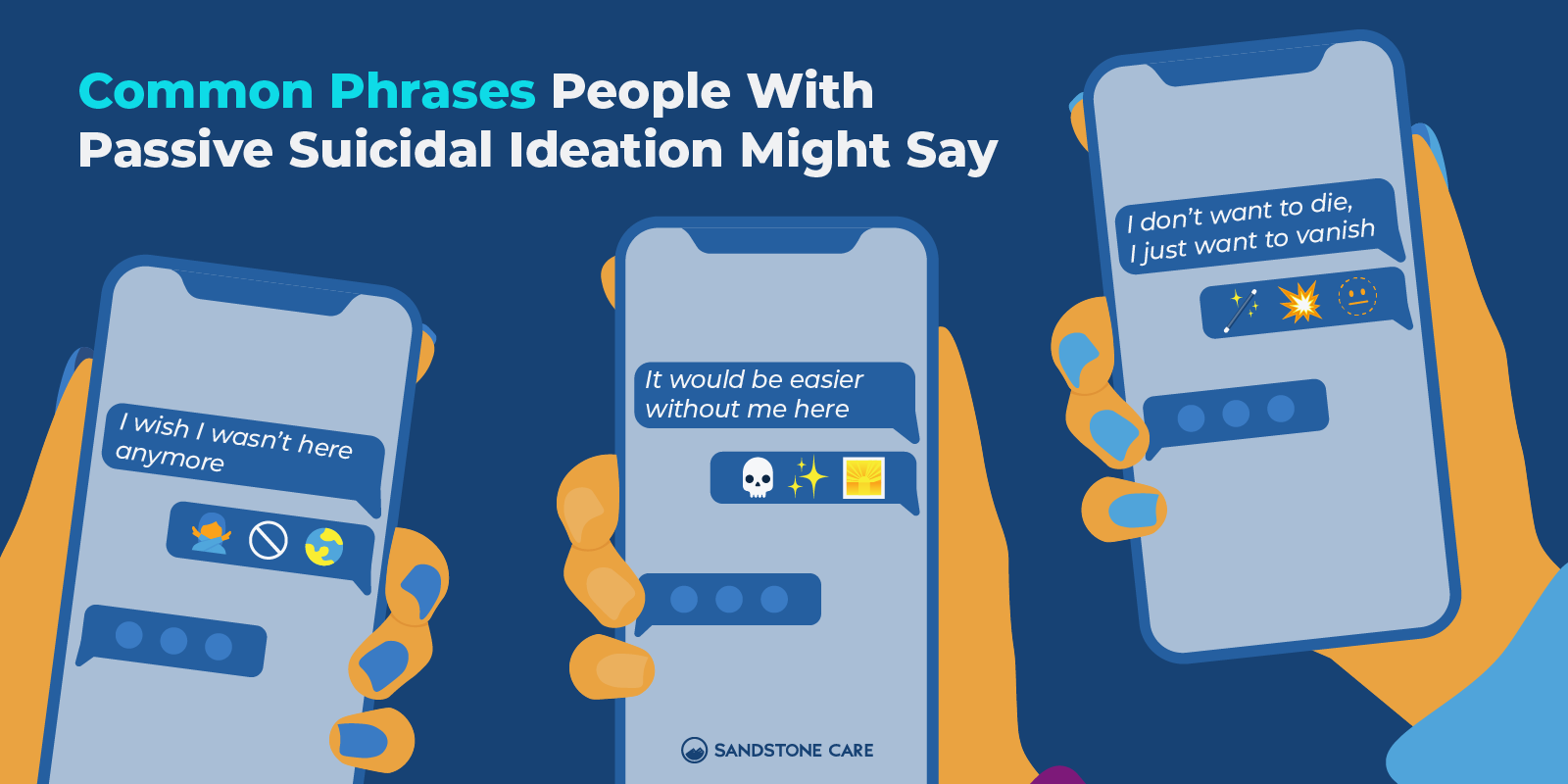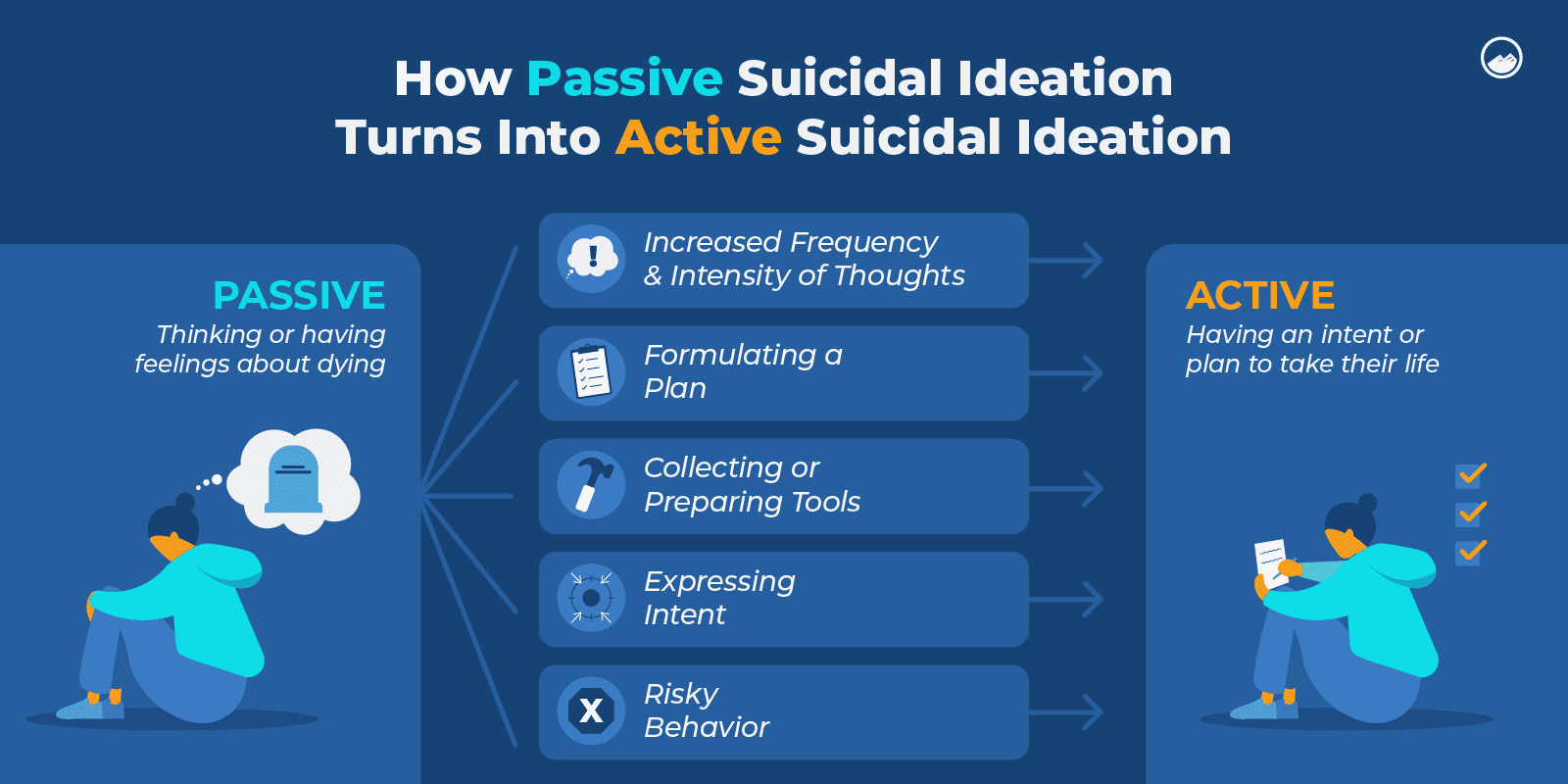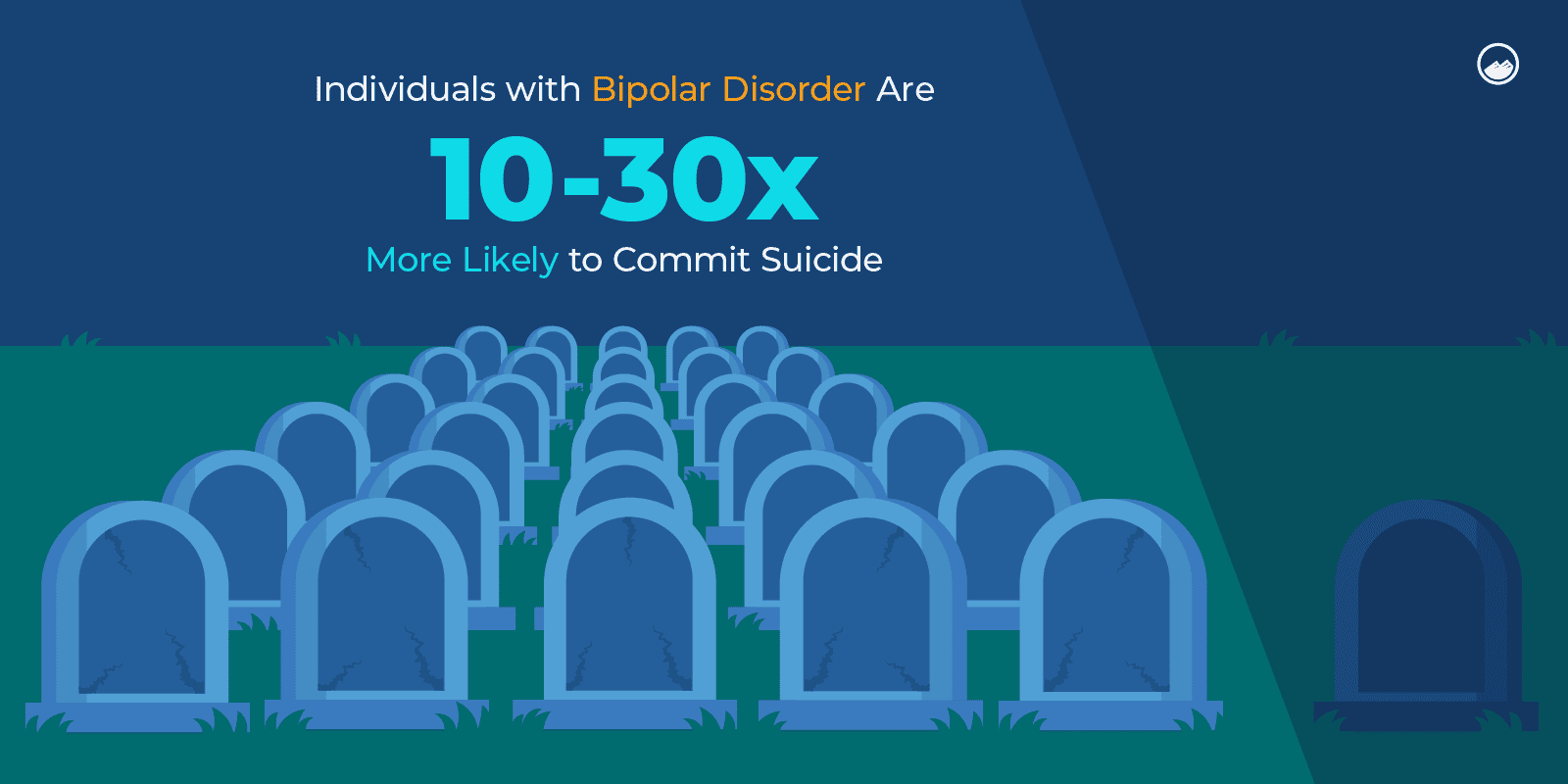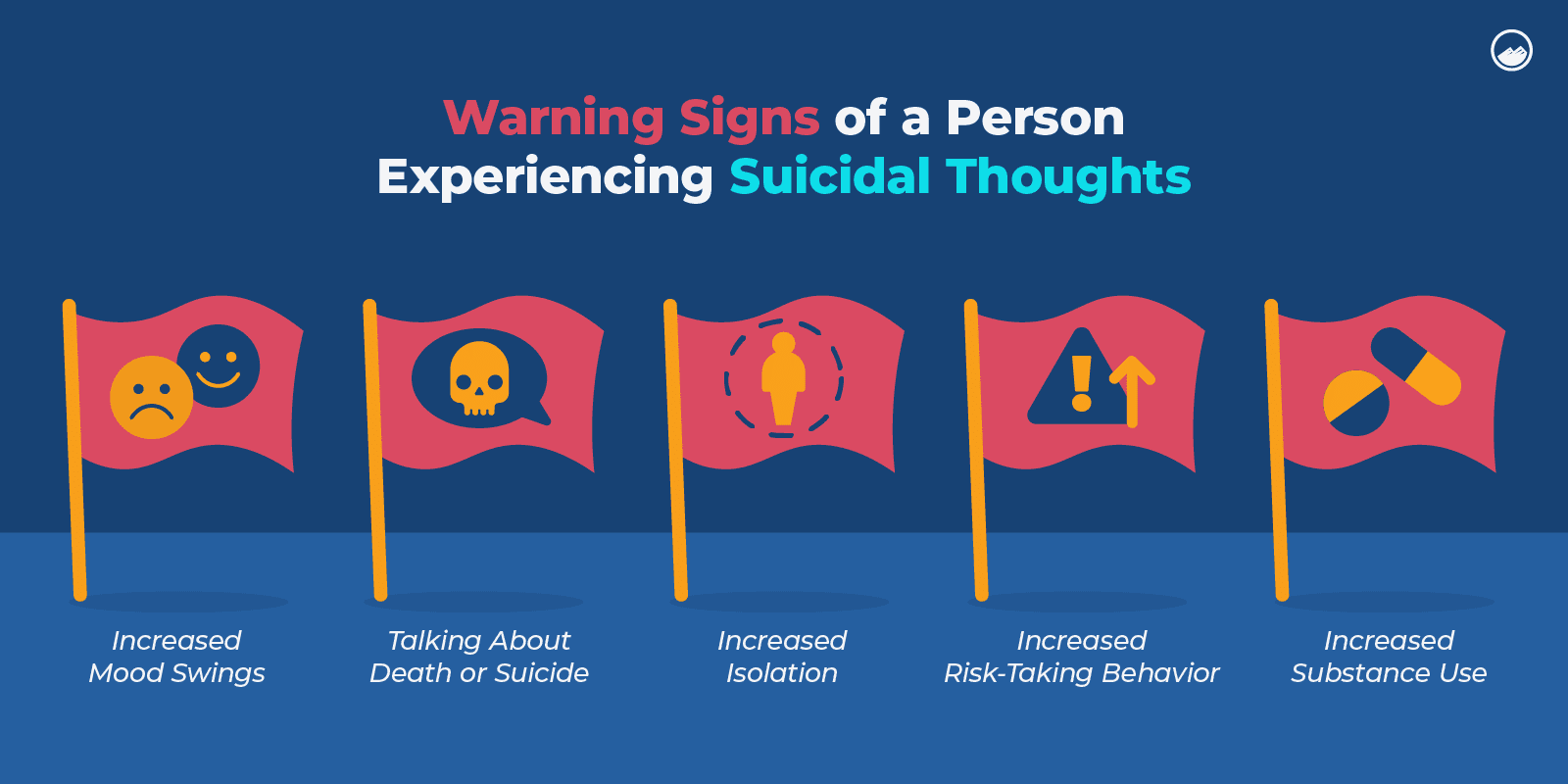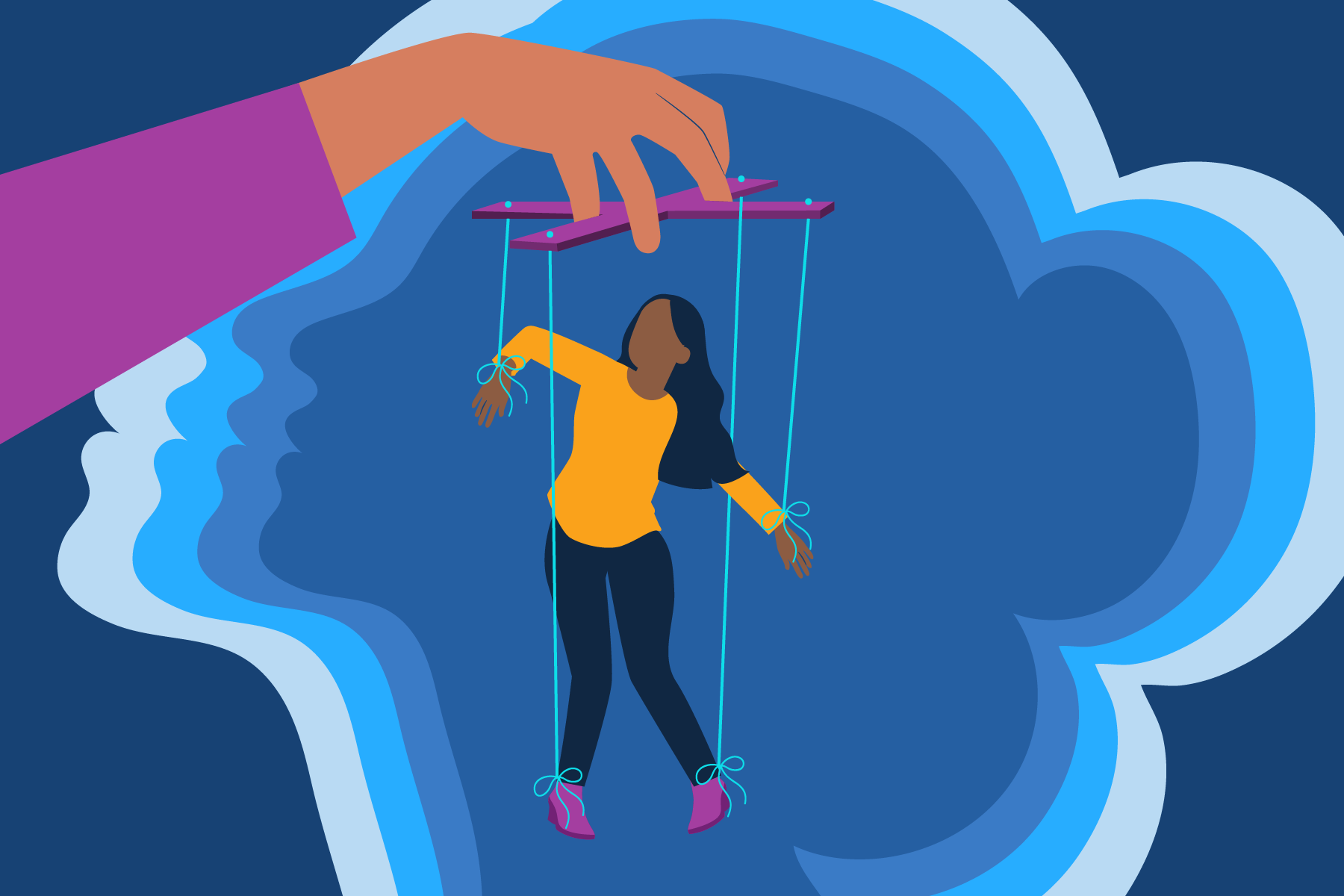Trigger warning: Content may include references to topics such as self-harm, suicide, death, and violence.
If you or a loved one is experiencing suicidal thoughts or is in imminent danger, reach out for help. You can call the National Suicide Prevention Lifeline at 988 or call 911.
You are not alone.
Passive Suicidal Ideation Overview
What Is Passive Suicidal Ideation?
Passive suicidal ideation is when a person has feelings or thoughts about wanting to die but has not made a specific plan to carry out suicide.
This can be common in individuals with depression or other mental health conditions. While this ideation can sometimes escalate into suicide attempts, it does not always.
Many who experience passive suicidal ideation will never act on their thoughts, but it is still crucial to recognize the signs of passive suicidal ideation because they do indicate a higher risk of suicide attempts in the future.
Is Passive Suicidal Ideation Bad?
Yes, passive suicidal ideation can serve as a red flag for underlying problems that may escalate if they are not handled with the proper care.
However, just because someone is entertaining vague thoughts of death or dying does not mean that they are actively suicidal.
Is Passive Suicidal Ideation Normal?
Passive suicidal ideation is not a normal thing to brush off.
If someone is experiencing passive suicidal ideation, it is a sign that there is something is going on. This could be associated with grief, mental illness, trauma, bullying, and more.
Although passive suicidal ideation is a critical sign to get help, it is not uncommon for people going through mental health challenges to experience some passive suicidal ideation.
What Is Passive Suicidal Ideation a Symptom of?
Passive suicidal ideation can be a symptom of mental health conditions such as:
- Major depressive disorder (Also known as major depression)
- Bipolar disorder
- ADHD
- Anxiety disorder
- Trauma
- Substance use and addiction
What Are the Risk Factors Associated with Passive Suicidal Ideation?
While anyone can have suicidal ideations, some risk factors that are commonly associated with passive suicidal ideation can include:
- Family history of attempted suicide, suicidal ideation, or suicide
- History of addiction
- Personal history of trauma
- Experiencing a significant loss, such as losing a family member
- Mood disorders
- Recently being diagnosed with a major physical illness
- Lack of access to treatment options and healthcare
Passive Suicidal Ideation Example
What Counts as Passive Suicidal Ideation?
Passive suicidal ideation occurs any time a person thinks about dying or wanting to die, but never actually plans to act on those thoughts.
This may include imagining how people would react to their death, feeling indifferent about whether they live or die, or imagining fatal scenarios such as car accidents.
It shifts from passive suicidal ideation to active suicidal ideation when the thoughts become specific, and a person starts to think about ways they might carry out the plan.
Active suicidal ideation may include dates, methods, or places, while passive suicidal ideation is never associated with a planned event.
However, just because passive suicidal ideation does not involve suicide attempts directly, it is still a critical sign that the person who is struggling is in need of help and supervision.
What Does Passive Suicidal Ideation Look Like?
Common phrases a person who is experiencing passive suicidal ideation might use can include:
- “I wish I wasn’t here anymore.”
- “It would be easier without me here.”
- “I don’t want to die, but I wish I just stopped existing.”
These statements, along with other expressions of self hatred, hopelessness, feeling like a burden, or wishing for an accident to happen, are common indicators of passive suicidal ideation.
Additionally, some signs a person might be having challenges with their mental health that could lead into suicidal ideation include:
- Engaging in risky behavior, including substance abuse
- Isolating themselves from loved ones
- Being easily irritable or agitated
- Experiencing sadness, hopelessness, unworthiness, shame
- Changes in sleeping and eating habits
- Self-harming
- Saying goodbye to friends or family members
It can be really hard to tell when someone is struggling, and a person might appear completely fine or happy on the surface level.
However, if you notice shifts or changes in their appearance compared to what you know about them, it can be worth bringing up and checking on them.
Passive Suicidal Ideation VS Active
What Is the Difference Between Active and Passive Suicidal Ideation?
Passive suicidal ideation involves thinking or having feelings about dying but not planning to carry it out, active ideation involves specific plans.
While both forms of suicidal ideation are serious and signal a need for help, active suicidal ideation is considered a situation of higher risk because the person is more likely to immediately harm themselves.
Active suicidal ideation is considered an emergency, and someone experiencing active suicidal ideation should get immediate intervention and reach out to a hotline for mental health treatment.
What Is Active Suicidal Ideation?
Someone experiencing active suicidal ideation has an intent and plan to take their life.
Active suicidal ideation goes beyond general, brief thoughts about dying. It involves specific considerations to how, when, and where they intend to take their life.
Can You Have Both Passive and Active Suicidal Ideation?
Yes. A person may have passive suicidal ideation at first, but once those thoughts and feelings become more specific, it turns into active suicidal ideation.
Not everyone who experiences passive suicidal ideation will go on to experience active suicidal ideation.
However, serious suicidal thoughts usually begin as passive ideation before escalating.
Passive Suicidal Ideation ADHD
What Is Passive Suicidal Ideation ADHD?
People with ADHD may experience passive suicidal ideation more frequently than those who do not have ADHD.
ADHD can also impact a person’s mood and emotion regulation, which links to the increased risk of passive suicidal ideation and depression.
Can ADHD Cause Suicidal Thoughts?
Suicidal thoughts can be more common among those who have been diagnosed with ADHD, however, ADHD on it’s own does not cause suicidal thoughts.
ADHD does cause emotional dysregulation and difficulties managing impulsive thoughts, which can increase the risk of passive suicidal ideation.
Impulsivity is recognized as a core symptom of ADHD, and impulsivity is correlated to suicidal behavior. This suicidal behavior can be both passive or active, depending on the severity of the situation.
Additionally, it is not uncommon for individuals with ADHD to be diagnosed with multiple, overlapping disorders such as conduct disorder, substance use, or depression.
These comorbid disorders can also increase the risk of suicidal thoughts and behaviors.
Are Suicidal Tendencies Common for People Suffering From ADHD?
ADHD can be associated with an increased risk of suicidal tendencies.
Research shows from the World Journal of Psychiatry that early recognition and treatment of ADHD can help people to find coping skills and coping mechanisms as a secondary prevention of suicide.
Passive Suicidal Ideation Bipolar
What Is Passive Suicidal Ideation in Bipolar?
The association between bipolar disorder and suicidal thoughts shows that individuals with bipolar disorder are at a higher risk of experiencing passive suicidal ideation and active suicidal ideation.
Bipolar disorder causes shifts in a person’s mood, behavior, energy, activity levels, and concentration.
The shifts that come with bipolar disorder can make it very difficult to get through everyday things.
Additionally, the rate of suicide among individuals with bipolar disorder is approximately 10 to 30 times higher than the general population.
Is Suicidal Ideation a Symptom of Bipolar Disorder?
Specifically during a depressive episode in bipolar disorder, suicidal ideation can occur because of low moods and negative thoughts surrounding oneself.
Can Bipolar Cause Suicidal Thoughts?
Suicidal thoughts can stem from symptoms of bipolar disorder.
Bipolar disorder can cause a person to go through manic episodes, depressive episodes, or mixed episodes.
During depressive episodes, a person can experience symptoms including:
- Lack of interest in activities or things they used to once love
- Feeling sad and anxious
- Experiencing feelings of hopelessness or worthlessness
- Having trouble concentrating or decision-making
- Difficulty doing simple tasks
These feelings of low mood and low energy can lead a person into a state where they have negative thoughts about themselves, their life, or the world. This can cause them to ruminate on thoughts of their own death.
How to Deal with Bipolar Suicidal Thoughts?
To start, the diagnosis and treatment of bipolar disorder can help prevent the condition from worsening or having a heavier impact on a person’s everyday life.
Treating bipolar disorder means helping an individual cope with their symptoms so that they can live fulfilling and balanced lives.
If a person with bipolar disorder is experiencing suicidal thoughts, they should let someone know right away. Someone who they trust, whether it is their mental health professional, therapist, family member, or friend.
If you are alone, try to find someone to be with who can support you and keep you company in a difficult time.
Individuals with bipolar disorder are at a higher risk of experiencing suicidal thoughts.
Some steps to take that might help prevent suicidal thoughts can include:
- Prioritizing self-care
- Exercising and moving your body
- Staying connected to your support system
- Going to therapy and getting medical help
Another important part of suicidal thought prevention with bipolar disorder is learning to recognize your warning signs when you feel your mental health declining.
Paying attention to your body and your mind, for example, noticing your mood becoming more frequently low or you’re becoming more easily irritated.
It is also important to notice when you feel disconnected from everyone or aren’t feeling like yourself.
Some people also keep a journal to help track their mood and feelings so it can help them reflect and notice patterns within themselves.
Recognizing these shifts in behavior, mood, or your general state can help you notice when you need support or need to take a step back and focus more on your mental health and overall well-being.
How to Cope with Passive Suicidal Ideation
What to Do When You Have Passive Suicidal Thoughts?
If you are having passive suicidal thoughts, it is important to talk to someone about it.
Whether with a family member, friend, counselor, or any adult you trust, talking about what thoughts you might be having can help you determine what steps you can take and how to get help.
Working out a safety plan with your support network can also help you figure out what steps to take when you are facing heightened challenges with your mental health.
A safety plan is a list that details specific coping strategies and sources of support for individuals who are at a higher risk of suicide.
A clinician can help a person develop a safety plan to make sure they have the tools and resources they might need in times of help.
Safety plans can help individuals learn how to recognize their warning signs, figure out internal coping strategies, identify people or places that can distract them or help them stay safe, identify professional contacts that can help them, and learn how to keep their environment safe.
When Should I Be Worried About Suicidal Thoughts?
Any type of suicidal thought can be a sign of an underlying problem and an indicator to reach out for help.
Just because someone is experiencing passive suicidal ideation and not active suicidal ideation does not mean that the situation isn’t serious and that there is nothing to worry about.
Any form of suicidal thoughts is a cause for concern.
If you think that you are going to harm yourself or anyone else, this is considered an emergency, and you should call for help right away.
How to Stop Passive Suicidal Ideation
The first step you can take to stop passive suicidal ideation is to talk to someone about it.
Having thoughts about harming yourself or taking your own life can be extremely difficult to understand and to know what to do about them or who to turn to.
What If a Friend Has Passive Suicidal Ideation?
It can be difficult to hear that a friend or loved one has been having thoughts about harming themselves.
However, it is a good sign that they felt safe enough to open up to you. Sometimes, someone needs a person to listen to them, to hear them out, and to just offer support by being there for them.
If a friend shares that they have been experiencing passive suicidal ideation with you, you can start by reminding them that they are not alone, that you are glad they told you, and let them know that you are there to help them.
Helping a friend with passive suicidal ideation get connected to professional help is extremely important.
This might look like encouraging them to talk to their healthcare provider, helping them look for a therapist to talk to, helping them contact their insurance, or a program that can help them find help that is available to them.
If a friend is experiencing suicidal thoughts and is discussing specific plans they are going to take, it is important that you get immediate help. Call 911 or the National Suicide Prevention Lifeline at 988.
Who Do I See if I Have Passive Suicidal Thoughts?
If you are having an emergency or are trying to harm yourself or other people, call 911 right away.
You can also call the National Suicide Prevention Lifeline at 988.
If you are having passive suicidal thoughts, talk to someone you trust.
This might be a family member, friend, counselor, or anyone else you feel safe talking to and who you might think can help you take the next step in getting help.
One of the most common ways to get help for passive suicidal thoughts is by talking to your doctor or a healthcare provider.
Let them know what you are going through so they can take the necessary steps to connect you and refer you to the right help.
Passive suicidal thoughts stem from an underlying problem, and treating them means treating what is truly going on inside.
This is why it is important to see a professional so that you can get a proper diagnosis and get the proper care you deserve.
How Can I Tell Someone That I Am Having Passive Suicidal Thoughts?
Opening up about mental health struggles and thoughts of suicide can be extremely scary and difficult to do.
You might not know who to go to or what to say.
Start by going to someone you trust and being in an environment you feel safe in.
Some ways you can tell a person you have been having passive suicidal thoughts can include:
- “This is very difficult to talk about, but I have been having passive suicidal thoughts, and it might help for me to talk to someone about it.”
- “I’m having a hard time right now. Can we talk about it?”
- “I have been experiencing passive suicidal thoughts and I don’t know where to go or to get help, can you help me find support?”








